A MoS2 Nanosheet-Based Fluorescence Biosensor for Simple and Quantitative Analysis of DNA Methylation
Abstract
:1. Introduction
2. Materials and Methods
2.1. Materials and Reagents
2.2. Apparatus
2.3. Endonuclease Digestion of Probe/Target DNA
2.4. Fluorescence Assays
2.5. Methylation Assay by Gel Electrophoresis
3. Results
3.1. Characterization of MoS2
3.2. Feasilbility of the Assay
3.3. Optimization of Assay Conditions
3.4. Kinetic Behavior
3.5. Detection of Target DNA
3.6. Quantitative Analysis of DNA Methylation
4. Conclusions
Supplementary Materials
Acknowledgments
Author Contributions
Conflicts of Interest
Abbreviations
| MoS2 | molybdenum disulfide |
| pds-DNA | partial duplex-deoxyribonucleic acid |
| ss-DNA | single stranded-deoxyribonucleic acid |
| ds-DNA | double stranded-deoxyribonucleic acid |
| Tris | Tris(hydroxylmethyl)aminom-ethan |
| NaCl | sodium chloride |
| MgCl2 | magnesium chloride |
| TEM | transmission electron microscopy |
| AFM | atomic force microscopy |
| DLS | dynamic light scattering |
| UV | ultraviolet |
| PAGE | polyacrylamide gel electrophoresis |
References
- Robertson, K.D.; Jones, P.A. DNA methylation: Past, present and future directions. Carcinogenesis 2000, 21, 461–467. [Google Scholar] [CrossRef] [PubMed]
- Cheng, X.; Roberts, R.J. AdoMet-dependent methylation, DNA methyltransferases and base flipping. Nucleic Acid Res. 2001, 29, 3784–3795. [Google Scholar] [CrossRef] [PubMed]
- Robertson, K.D. DNA methylation and human disease. Nat. Rev. Genet. 2005, 6, 597–610. [Google Scholar] [CrossRef] [PubMed]
- Herman, J.G.; Graff, J.R.; Myöhänen, S.; Nelkin, B.D.; Baylin, S.B. Methylation-specific PCR: A novel PCR assay for methylation status of CpG islands. Proc. Natl. Acad. Sci. USA 1996, 93, 9821–9826. [Google Scholar] [CrossRef] [PubMed]
- Hu, J.; Zhang, C. Single base extension reaction-based surface enhanced Raman spectroscopy for DNA methylation assay. Biosens. Bioelectron. 2011, 31, 451–457. [Google Scholar] [CrossRef] [PubMed]
- Wu, Y.; Zhang, B.; Guo, L.H. Label-free and selective photoelectrochemical detection of chemical DNA methylation damage using DNA repair enzymes. Anal. Chem. 2013, 85, 6908–6914. [Google Scholar] [CrossRef] [PubMed]
- Jones, P.A.; Baylin, S.B. The fundamental role of epigenetic events in cancer. Nat. Rev. Genet. 2002, 3, 415–428. [Google Scholar] [PubMed]
- Fryer, A.A.; Nafee, T.M.; Ismail, K.M.; Carroll, W.D.; Emes, R.D.; Farrell, W.E. Line-1 DNA methylation is inversely correlated with cord plasma homocysteine in man: A preliminary study. Epigenetics 2009, 4, 394–398. [Google Scholar] [CrossRef] [PubMed]
- Zhang, J.; Xing, B.; Song, J.; Zhang, F.; Nie, C.; Jiao, L.; Liu, L.; Lv, F.; Wang, S. Associated analysis of DNA methylation for cancer detection using CCP-based FRET technique. Anal. Chem. 2014, 86, 346–350. [Google Scholar] [CrossRef] [PubMed]
- Laird, P.W. The power and the promise of DNA methylation markers. Nat. Rev. Cancer 2003, 3, 253–266. [Google Scholar] [CrossRef] [PubMed]
- Yu, J.; Cheng, Y.Y.; Tao, Q.; Cheung, K.F.; Lam, C.N.Y.; Geng, H.; Tian, L.W.; Wong, Y.P.; Tong, J.H.M.; Ying, J.M.; et al. Methylation of protocadherin 10, a novel tumor suppressor, is associated with poor prognosis in patients with gastric cancer. Gastroenterology 2009, 136, 640–651. [Google Scholar] [CrossRef] [PubMed]
- Feng, F.; Wang, H.; Han, L.; Wang, S. Fluorescent conjugated polyelectrolyte as an indicator for convenient detection of DNA methylation. J. Am. Chem. Soc. 2008, 130, 11338–11343. [Google Scholar] [CrossRef] [PubMed]
- Ibrahim, M.A. Advances in genomic DNA methylation analysis. Biotechnology 2010, 9, 459–468. [Google Scholar] [CrossRef]
- Lei, C.; Huang, Y.; Nie, Z.; Hu, J.; Li, L.; Lu, G.; Han, Y.; Yao, S. A supercharged fluorescent protein as a versatile probe for homogeneous DNA detection and methylation analysis. Angew. Chem. 2014, 126, 8498–8502. [Google Scholar] [CrossRef]
- Wang, J.; Zhu, Z.; Ma, H. Label-free real-time detection of DNA methylation based on quartz crystal microbalance measurement. Anal. Chem. 2013, 85, 2096–2101. [Google Scholar] [CrossRef] [PubMed]
- Maki, W.C.; Mishra, N.N.; Cameron, E.G.; Filanoski, B.; Rastogi, S.K.; Maki, G.K. Nanowire-transistor based ultra-sensitive DNA methylation detection. Biosens. Bioelectron. 2008, 23, 780–787. [Google Scholar] [CrossRef] [PubMed]
- Dai, Z.; Hu, X.; Wu, H.; Zou, X. A label-free electrochemical assay for quantification of gene-specific methylation in a nucleic acid sequence. Chem. Commun. 2012, 48, 1769–1771. [Google Scholar] [CrossRef] [PubMed]
- Geng, Y.; Wu, J.; Shao, L.; Yan, F.; Ju, H. Sensitive colorimetric biosensing for methylation analysis of p16/CDKN2 promoter with hyperbranched rolling circle amplification. Biosens. Bioelectron. 2014, 61, 593–597. [Google Scholar] [CrossRef] [PubMed]
- Zhu, C.; Zeng, Z.; Li, H.; Li, F.; Fan, C.; Zhang, H. Single-layer MoS2-based nanoprobes for homogeneous detection of biomolecules. J. Am. Chem. Soc. 2013, 135, 5998–6001. [Google Scholar] [CrossRef] [PubMed]
- Huang, Y.; Shi, Y.; Yang, H.Y.; Ai, Y. A novel single-layered MoS2 nanosheet based microfluidic biosensor for ultrasensitive detection of DNA. Nanoscale 2015, 7, 2245–2249. [Google Scholar] [CrossRef] [PubMed]
- Zhang, Y.; Zheng, B.; Zhu, C.; Zhang, X.; Tan, C.; Li, H.; Chen, B.; Yang, J.; Chen, J.; Huang, Y.; et al. Single-layer transition metal dichalcogenide nanosheet-based nanosensors for rapid, sensitive, and multiplexed detection of DNA. Adv. Mater. 2014, 27, 935–939. [Google Scholar] [CrossRef] [PubMed]
- Yang, G.; Zhu, C.; Du, D.; Zhu, J.; Lin, Y. Graphene-like two-dimensional layered nanomaterials: Applications in biosensors and nanomedicine. Nanoscale 2015, 7, 14217–14231. [Google Scholar] [CrossRef] [PubMed]
- Zhang, H.Y.; Ruan, Y.J.; Lin, L.; Lin, M.; Zeng, X.; Xi, Z.; Fu, F. A turn-off fluorescent biosensor for the rapid and sensitive detection of uranyl ion based on molybdenum disulfide nanosheets and specific DNAzyme. Spectrochim. Acta Part A 2015, 146, 1–6. [Google Scholar] [CrossRef] [PubMed]
- Xiang, X.; Shi, J.; Huang, F.; Zheng, M.; Deng, Q.; Xu, J. MoS2 nanosheet-based fluorescent biosensor for protein detection via terminal protection of small-molecule-linked DNA and exonuclease III-aided DNA recycling amplification. Biosens. Bioelectron. 2015, 74, 227–232. [Google Scholar] [CrossRef] [PubMed]
- Jia, L.; Ding, L.; Tian, J.; Bao, L.; Hu, Y.; Ju, H.; Yu, J.S. Aptamer loaded MoS2 nanoplates as nanoprobes for detection of intracellular ATP and controllable photodynamic therapy. Nanoscale 2015, 7, 15953–15961. [Google Scholar] [CrossRef] [PubMed]
- Ji, L.; Cai, Z.; Qian, Y.; Wu, P.; Zhang, H.; Cai, C. Highly sensitive methyltransferase activity assay and inhibitor screening based on fluorescence quenching of graphene oxide integrated with the site-specific cleavage of restriction endonuclease. Chem. Commun. 2014, 50, 10691–10694. [Google Scholar] [CrossRef] [PubMed]
- Ou, J.Z.; Chrimes, A.F.; Wang, Y.; Tang, S.Y.; Strano, M.S.; Kalantar-Zadeh, K. Ion-driven photoluminescence modulation of quasi-two-dimensional MoS2 nanoflakes for applications in biological systems. Nano Lett. 2014, 14, 857–863. [Google Scholar] [CrossRef] [PubMed]
- Kalantar-Zadeh, K.; Ou, J.Z.; Daeneke, T.; Strano, M.S.; Pumera, M.; Gras, S.L. Two-dimensional transition metal dichalcogenides in biosystems. Adv. Funct. Mater. 2015, 25, 5086–5099. [Google Scholar] [CrossRef]
- Muren, N.B.; Barton, J.K. Electrochemical assay for the signal-on detection of human DNA methyltransferase activity. J. Am. Chem. Soc. 2013, 135, 16632–16640. [Google Scholar] [CrossRef] [PubMed]
- Yin, H.; Yang, Z.; Li, B.; Zhou, Y.; Ai, S. Electrochemical biosensor for DNA demethylase detection based on demethylation triggered endonuclease BstUI and exonuclease III digestion. Biosens. Bioelectron. 2015, 66, 266–270. [Google Scholar] [CrossRef] [PubMed]
- Wang, S.; Zhang, Y.; Ning, Y.; Zhang, G.J. A WS2 nanosheet-based platform for fluorescent DNA detection via PNA-DNA hybridization. Analyst 2014, 140, 434–439. [Google Scholar] [CrossRef] [PubMed]
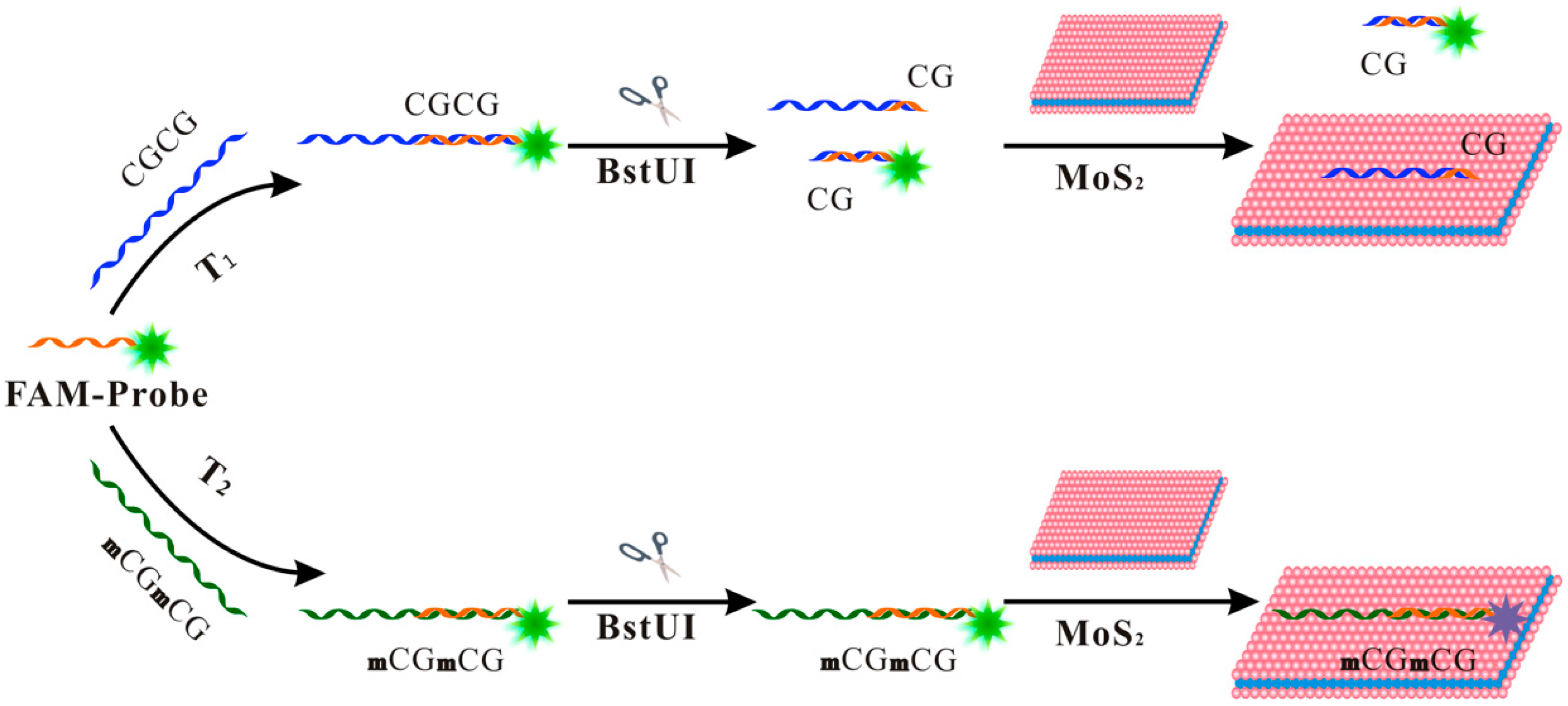
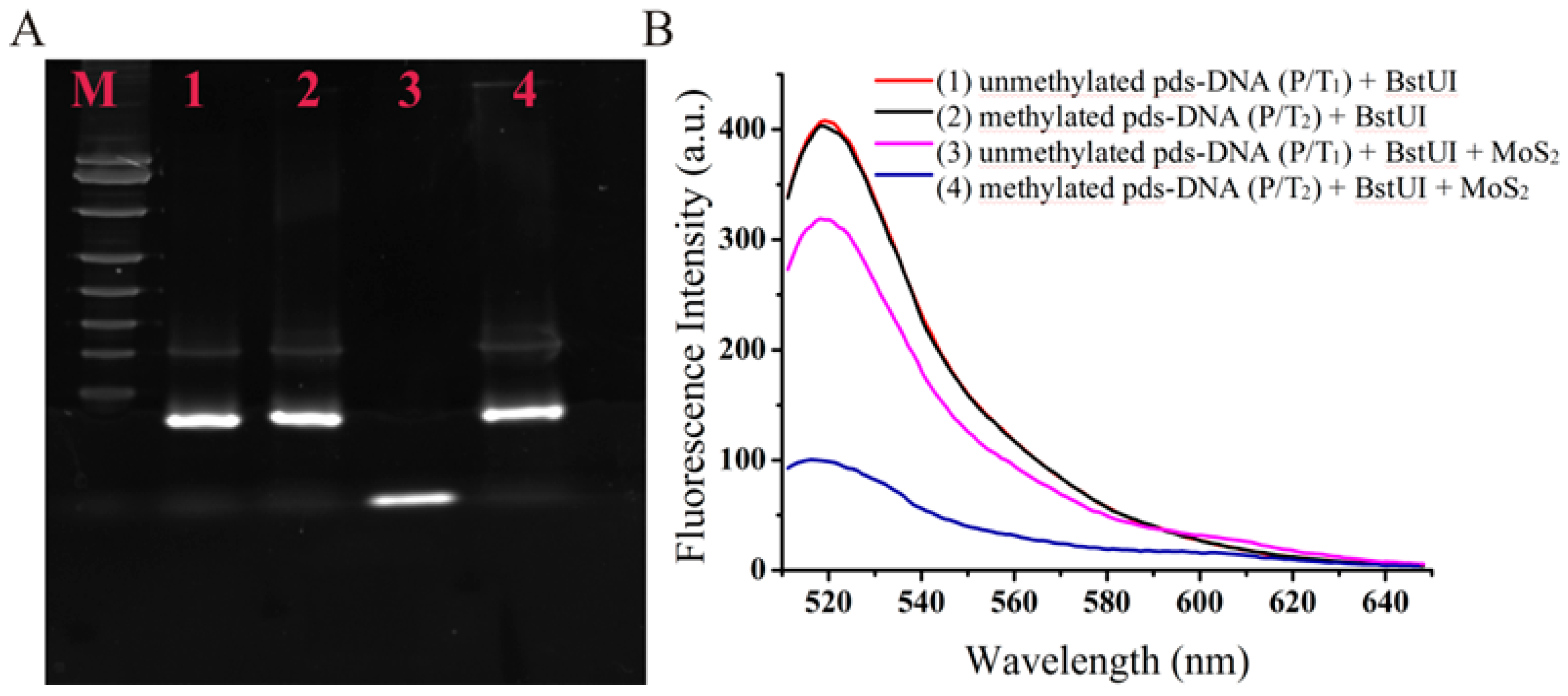
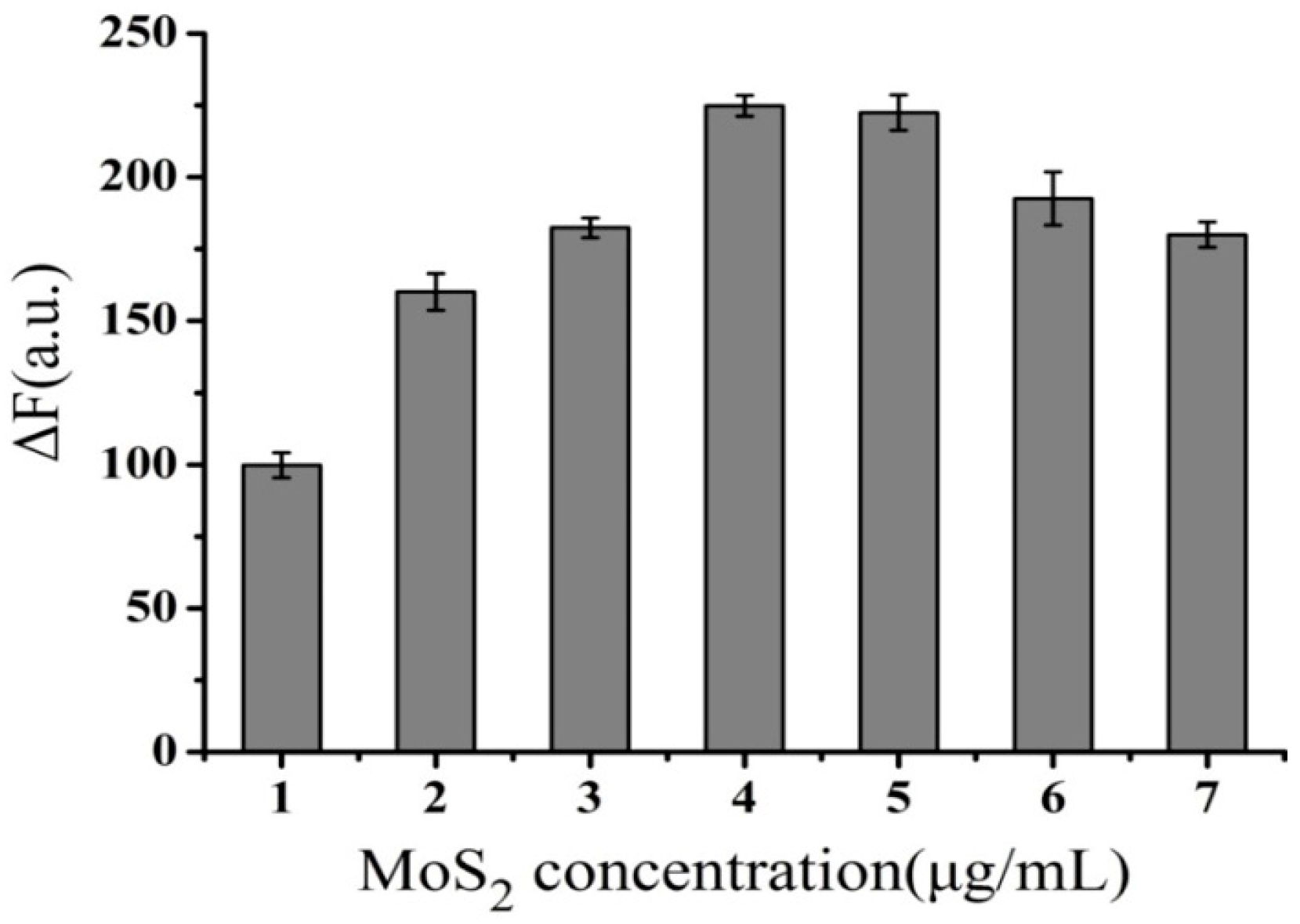
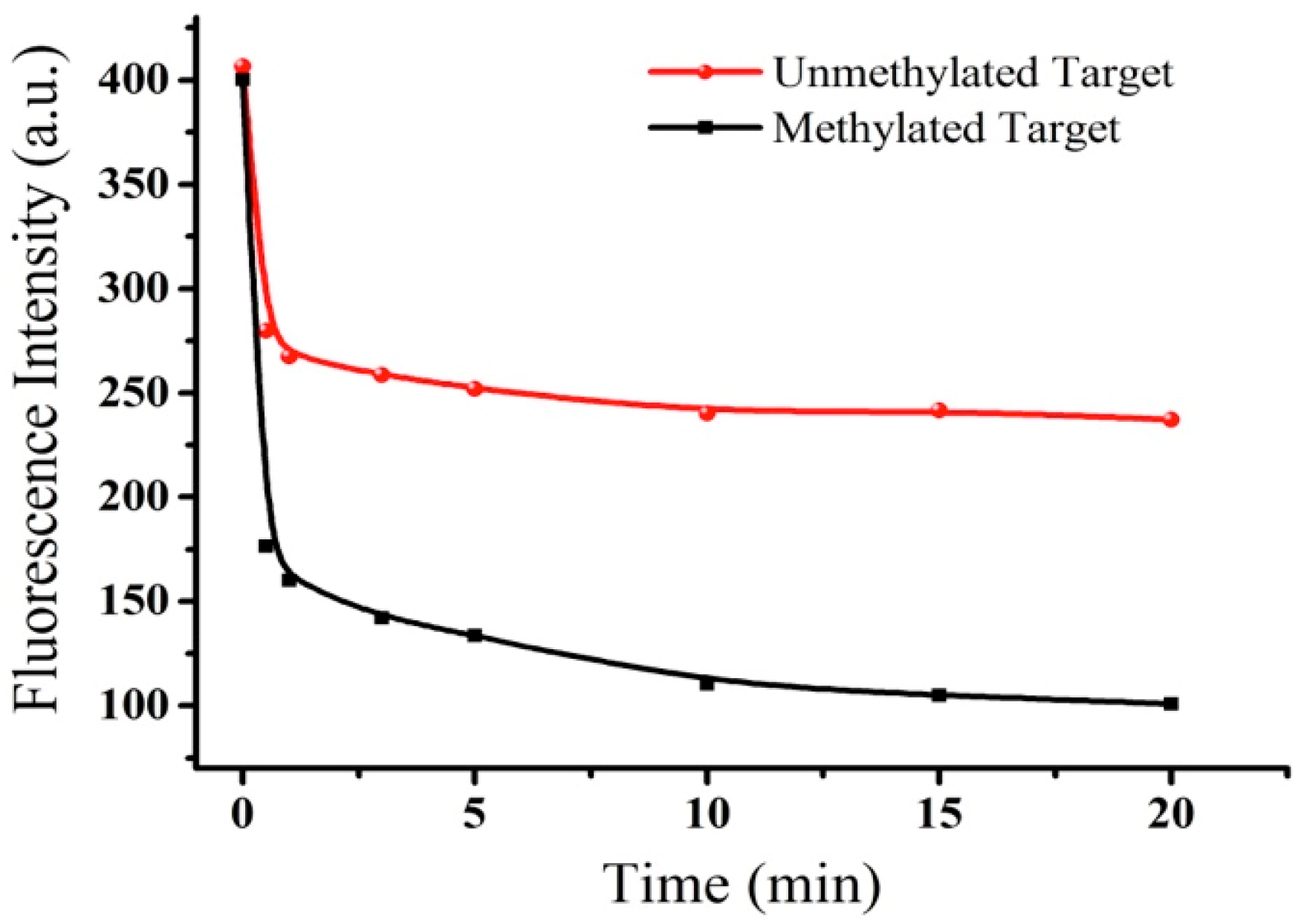
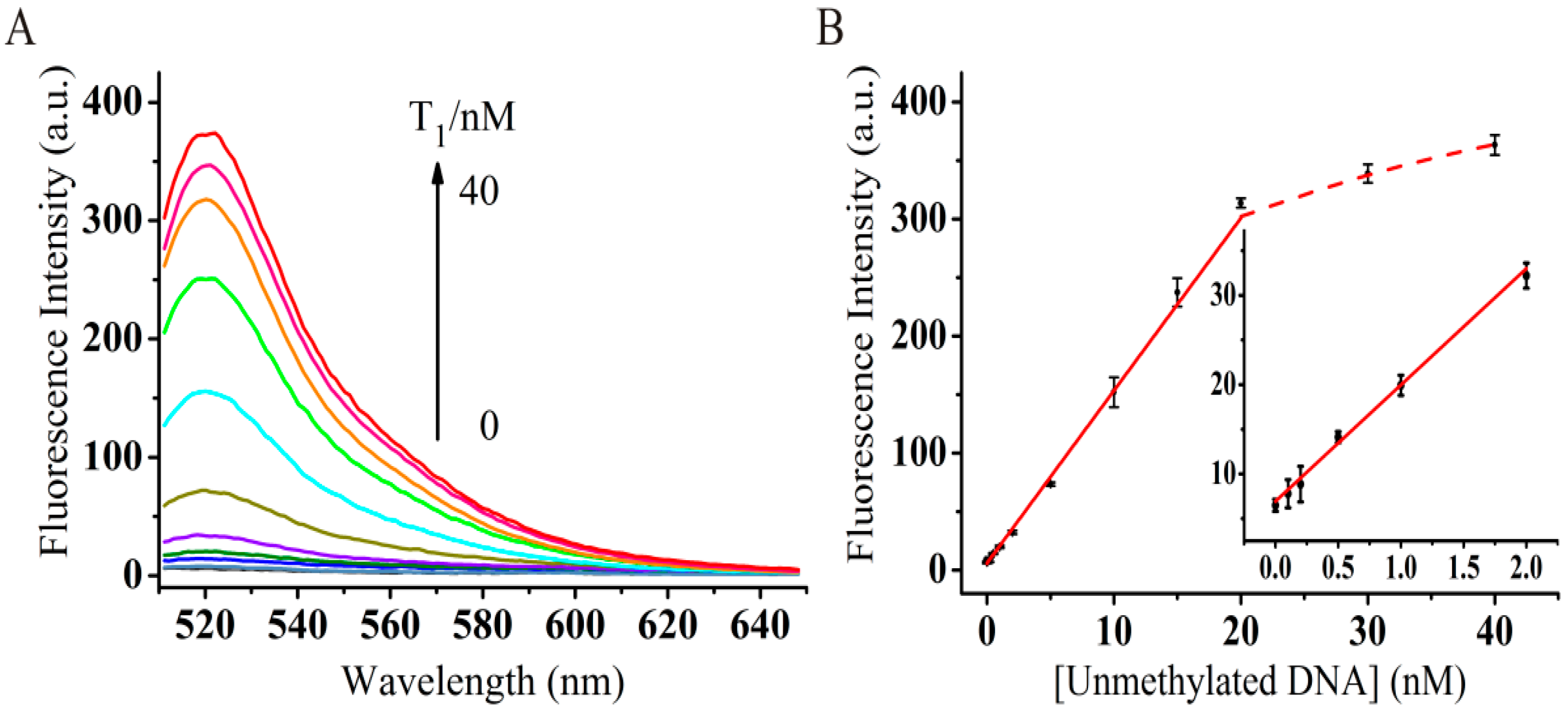
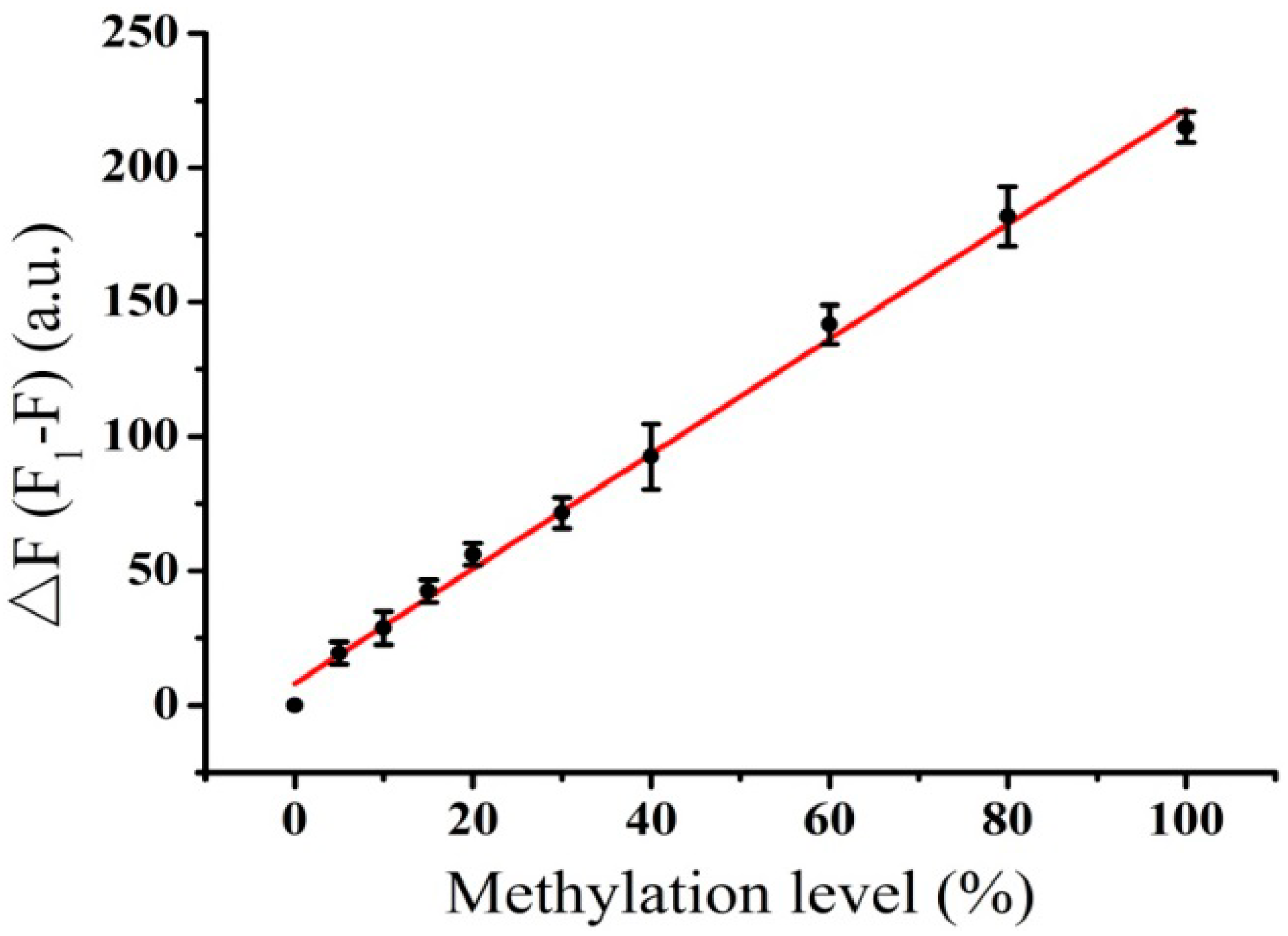
| Oligonucleotides | Gene Sequences (5′–3′) |
|---|---|
| FAM-Probe DNA (P) | FAM-GAC CCC GGG CCG CGG CCG TGG |
| Unmethylated target DNA (T1) | AGC AGC ATG GAG CCT TCG GCT GAC TGG CTG GCC ACG GCC GCG GCC CGG GGT C |
| Methylated target DNA (T2) | AGC AGC ATG GAG CCT TCG GCT GAC TGG CTG GCC ACG GCmC GmCG GCC CGG GGT C |
| One base mismatched DNA (M) | AGC AGC ATG GAG CCT TCG GCT GAC TGG CTG GCC ACG GCC TCG GCC CGG GGT C |
| Non-complementary DNA (N) | CTT GAT ATT CGG CAC ATA GTC CTG GGA GAG ACC GGC GCA CAG AGG AAG AGA A |
© 2016 by the authors; licensee MDPI, Basel, Switzerland. This article is an open access article distributed under the terms and conditions of the Creative Commons Attribution (CC-BY) license (http://creativecommons.org/licenses/by/4.0/).
Share and Cite
Xiao, L.; Xu, L.; Gao, C.; Zhang, Y.; Yao, Q.; Zhang, G.-J. A MoS2 Nanosheet-Based Fluorescence Biosensor for Simple and Quantitative Analysis of DNA Methylation. Sensors 2016, 16, 1561. https://doi.org/10.3390/s16101561
Xiao L, Xu L, Gao C, Zhang Y, Yao Q, Zhang G-J. A MoS2 Nanosheet-Based Fluorescence Biosensor for Simple and Quantitative Analysis of DNA Methylation. Sensors. 2016; 16(10):1561. https://doi.org/10.3390/s16101561
Chicago/Turabian StyleXiao, Le, Li Xu, Chuan Gao, Yulin Zhang, Qunfeng Yao, and Guo-Jun Zhang. 2016. "A MoS2 Nanosheet-Based Fluorescence Biosensor for Simple and Quantitative Analysis of DNA Methylation" Sensors 16, no. 10: 1561. https://doi.org/10.3390/s16101561






